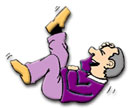Why is it that if you tickle yourself it doesn't tickle?
[ 2006-04-29 11:28 ]
When you are
tickled, your laughter is the reaction that occurred because
that ticklish feeling sends us into a state of panic. You most
likely weren't expecting that person to sneak up behind
you  and tickle your sides, were you? This was probably
a defense mechanism that developed in our cave-men ancestors
to detect predators. and tickle your sides, were you? This was probably
a defense mechanism that developed in our cave-men ancestors
to detect predators.
When you try to tickle yourself you are in complete control
of the situation, there is no need to get tense and therefore
there is no reaction.
The part of the brain that cancels out stimuli it is
expecting is called the cerebellum. The
cauliflower-like mass can be found at the back, under
the brain. The cerebellum is known to basically be the party
planner, it coordinates movement control in relation to
sensory signals received in other areas of your brain.
It is possible to tickle yourself though!!!
You would have to fool your cerebellum. Studies have shown
that with as little of a 200-millisecond delay between you
moving your hand and the tickling, you would react. However
there is only one way to do this- by remote control.
Science has been able to design a robot that allows people
to tickle themselves. To use the machine you would have to lie
on your back with your eyes closed. The robot, located near
you, would have a piece of soft foam attached to a plastic rod
which you would control by joystick. 操縱桿You would
maneuver the remote control and after a short delay, would
respond. This takes advantage of the delay in the
cerebellum.
|
sneak up: 悄悄出現(xiàn)�,突然接近
cerebellum: 小腦
cauliflower: 花椰菜
joystick: 操縱桿 | | |
|